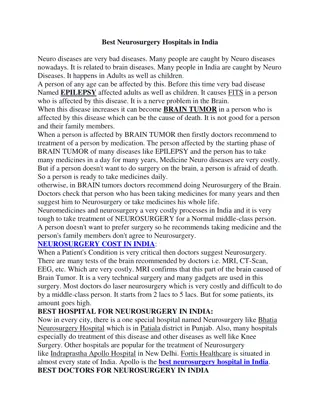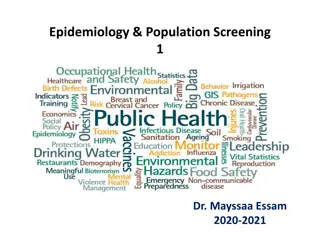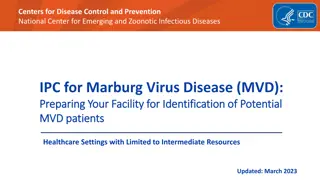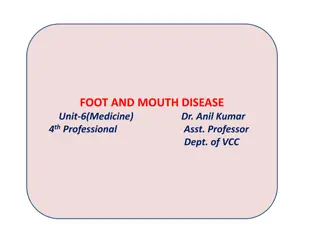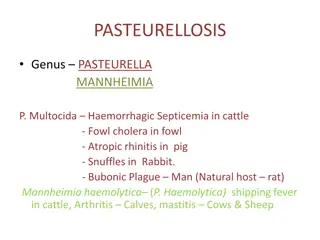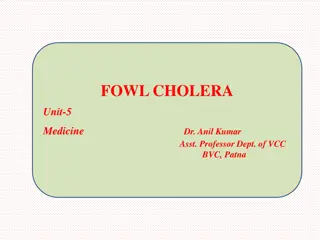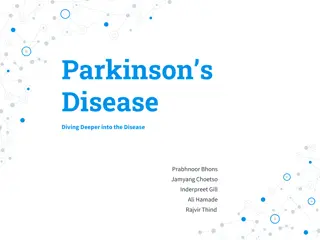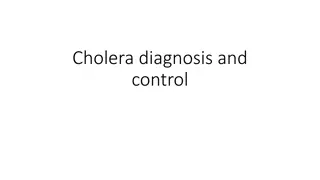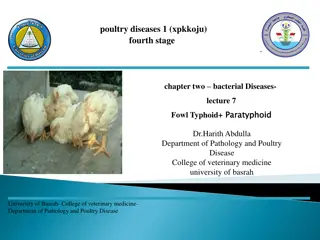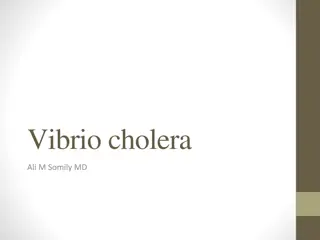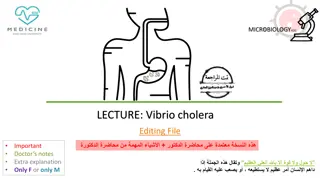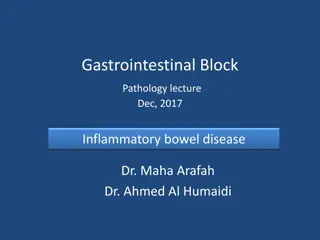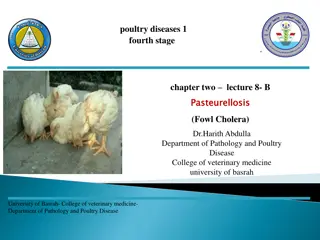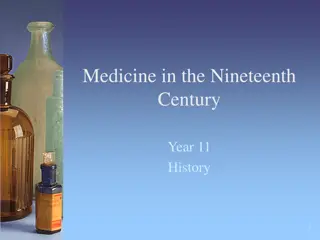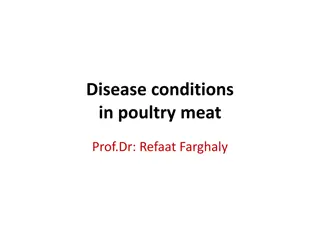Understanding Steatotic Liver Disease: Importance, Epidemiology, and Pathology
Steatotic liver disease, including metabolic dysfunction associated steatohepatitis (MASLD) and metabolic associated alcoholic liver disease (MALD), is a common cause of liver test abnormalities in the United States. Risk factors such as obesity and metabolic syndrome can lead to advanced fibrosis a
1 views • 44 slides
Innovations in Infectious Disease Control: Insights from Experts
Explore the latest advancements in infectious disease control through the lens of renowned epidemiologists and researchers. Delve into the impact of the COVID-19 pandemic, the historical prevalence of infectious diseases, and early infection prevention practices. Uncover the evolution of infectious
0 views • 22 slides
Overview of Poultry Diseases and their Causes
Poultry diseases caused by viruses and bacteria are a significant concern for poultry farmers. Viral diseases like Ranikhet Disease, Fowl Pox, and Avian Leucosis can have high mortality rates and severe symptoms. Bacterial diseases such as Tick Fever, Tuberculosis, Fowl Cholera, and Infectious Coryz
2 views • 12 slides
Understanding the Natural History of Disease Development and Prevention
The natural history of disease development outlines the progression of a disease in an individual without intervention, from exposure to outcome. Learning objectives include defining prevention terms, understanding disease severity, prevention levels, and intervention measures. Studying disease prog
4 views • 16 slides
Building Resilience Against Cholera Outbreaks: Lessons from IHR Framework
Exploring how the International Health Regulations (IHR) can enhance preparedness and response to cholera outbreaks. Discusses the functional components of IHR, the role of National IHR Focal Points, and best practices in building resilience. Highlights the importance of coordination, communication,
1 views • 20 slides
Update on Cholera Outbreak in Gauteng and Free State Provinces - May 24, 2023
National Institute for Communicable Diseases confirmed a Cholera outbreak in Gauteng and Free State Provinces. A total of 53 cases have been confirmed, with 9 in Free State and 44 in Gauteng. Updates on cases, testing, and hospital admissions provided. Stay informed about the current situation.
1 views • 21 slides
A Look Into Cholera Control and WASH Services Worldwide
The World Health Organization, along with the Global Task Force for Cholera Control, is focusing on analyzing reported cholera cases from 2010-2021 and the levels of water, sanitation, and hygiene (WASH) services in various countries. The report highlights the importance of basic WASH services in pr
3 views • 9 slides
Best Neurosurgery Hospitals in India
Neuro diseases are very bad diseases. Many people are caught by Neuro diseases nowadays. It is related to brain diseases. Many people in India are caught by Neuro Diseases. It happens in Adults as well as children.\nA person of any age can be affected by this. Before this time very bad disease Named
1 views • 2 slides
Principles of Epidemiology: Understanding Disease Occurrence and Surveillance
Epidemiology is the study of disease patterns, factors influencing disease occurrence, and the core functions of surveillance, field investigation, and analytic studies. It involves understanding disease characteristics, natural history, and evaluating the effectiveness of activities to mitigate dis
1 views • 25 slides
Understanding Epidemiology: Disease Distribution and Population Health
Epidemiology is the study of disease distribution in populations, analyzing patterns, determinants, and risk factors to understand and control various health conditions. It encompasses infectious diseases like cholera, nutritional disorders such as scurvy, cancers like childhood leukemia, and non-co
1 views • 16 slides
Heart Health Jeopardy - Test Your Knowledge on Heart Disease
Test your knowledge on heart disease with this Heart Health Jeopardy game. Learn about heart disease facts, statistics, risk factors, and common types of heart diseases. Understand the importance of recognizing heart attack symptoms and the significance of factors like high blood pressure, high chol
0 views • 58 slides
Understanding the Use of Maps in Public Health
Maps play a crucial role in public health by visualizing health data, trends, and locations of health events. They are used to communicate information such as disease rates, outbreaks, and causal factors. Spot maps show individual case locations, while area maps use colors or shades to communicate t
0 views • 15 slides
Understanding Vibrio Cholerae: Biology and Impact on Human Health
Vibrio cholerae is a significant bacterium responsible for causing cholera, a life-threatening diarrheal disease. With over 35 species in the Vibrio genus, only a few can infect humans. Vibrio cholerae is a Gram-negative, curved aerobic rod that produces an enterotoxin leading to cholera. Understand
0 views • 23 slides
Overview of Vibrio cholerae: Characteristics and Identification
Vibrio cholerae is a gram-negative, curved rod bacterium known for causing cholera. Its distinctive features include polar flagellum motility, oxidase-positive nature, and resistance to inhibitory substances. Various culture media are used for its isolation and growth, such as transport, routine, an
0 views • 8 slides
Impact of Industrial Revolution on European Society
The Industrial Revolution had a profound impact on European society, characterized by key terms such as Agricultural Revolution, Capital, Pig Iron, Wrought Iron, Tariffs, Cholera, and Trade Unions. This period saw advancements in agricultural techniques, the rise of material wealth for production, t
1 views • 24 slides
Insights into Tyzzer's Disease: An Overview of a Bacterial Infection in Laboratory Animals
Tyzzer's disease is an acute bacterial infection affecting rodents and rabbits, caused by Clostridium piliforme. Discovered in 1917 by Ernest Tyzzer, the disease is characterized by necrotic lesions in the caecal mucosa, liver, and heart. Initially known as Bacillus piliformis, it was later renamed
2 views • 21 slides
Importance of Screening and Separation in Marburg Virus Disease Control
Early identification and separation of suspected Marburg virus disease patients play a crucial role in preventing the spread of the disease within healthcare settings. Screening and setting up specific areas for identification and isolation are essential steps to protect healthcare workers, patients
1 views • 15 slides
Foot and Mouth Disease: Overview, Symptoms, and Sequelae
Foot and Mouth Disease, also known as Aphthous fever, is a highly contagious viral infection affecting cloven-hoofed animals. It is characterized by the formation of vesicles and erosions in the mouth, nose, teats, and feet. The disease can cause a fall in milk yield, high fever, loss of appetite, a
1 views • 8 slides
Understanding Disease Control and Prevention in Epidemiology
This article discusses disease control processes in epidemiology, including reducing disease incidence, duration, and transmission. It covers public policy interventions, elimination, eradication, and extinction of infectious agents. It also highlights preventable causes of disease and different lev
2 views • 10 slides
Overview of Pasteurellosis in Livestock
Pasteurellosis, caused by Pasteurella and Mannheimia species, affects various animals from cattle to fowl. It presents as hemorrhagic septicemia in cattle, fowl cholera in fowl, atropic rhinitis in pigs, and more. The disease is characterized by small, non-hemolytic colonies and specific biochemical
0 views • 30 slides
Understanding Fowl Cholera in Birds: Causes, Symptoms, and Management
Fowl cholera, a septicaemic disease affecting birds, is caused by Pasteurella multocida. It can affect all species of birds, with older birds more susceptible. The disease can spread through carrier birds, excretions, carcasses, and even rats. The virulence factors, clinical signs, and forms of the
2 views • 9 slides
Understanding Parkinson's Disease: Diving Deeper into the Neurodegenerative Disorder
Parkinson's disease is a neurodegenerative disorder that impacts dopamine levels in the brain. The history, epidemiology, causes, and pathophysiology of the disease are explored, shedding light on its significant impact on the nervous system. Genetic and environmental factors play a role in the deve
0 views • 25 slides
Dealing with Disease in Early Modern Britain
Explore the methods of treating disease in Early Modern Britain, including advancements in surgery by Ambroise Pare and Andreas Vesalius, the prevalence of quackery in medicine sales, and the impact of individuals like Lady Johanna St. John and Nicholas Culpeper. Evaluate the effectiveness of diseas
0 views • 8 slides
Screening for Peripheral Vascular Disease in Patients with Coronary Artery Disease
Patients with coronary artery disease should be screened for peripheral vascular disease as it is a frequent integrator of global cardiovascular risk. The association of atherosclerosis in various arterial diseases highlights the importance of identifying multisite artery disease. The prevalence and
0 views • 23 slides
Human Disease Symptom Network: Understanding Disease Relationships Through Symptoms and Genes
The Human Disease Symptom Network (HSDN) is constructed using a large-scale medical bibliographic records database to form a network of human diseases based on symptom similarities. By integrating disease-gene associations and protein-protein interaction data, correlations between symptom similarity
0 views • 37 slides
Understanding Cholera - Causes, Symptoms, and Prevention Strategies
Cholera is an acute intestinal infection caused by the bacterium Vibrio cholerae. It leads to watery diarrhea due to the production of a potent enterotoxin. The disease has two distinct life cycles - one in the environment and one in humans. Factors such as access to safe water and sanitation play a
0 views • 21 slides
Understanding Bacterial Diseases of Fish: Columnaris Disease Overview
Columnaris disease, also known as Saddleback disease, is a common bacterial infection in fish that is often brought about by poor handling and high stress levels. This disease manifests as tail and fin rot, leading to rapid fish mortality. The causative organism, Cytophaga (formerly Flexibacter), is
0 views • 21 slides
Cholera Diagnosis and Control Methods Overview
Cholera diagnosis involves various laboratory tests such as specimen analysis, smears, and cultures. Slide agglutination tests and the oxidase test can also aid in the identification of Vibrio cholerae bacteria. Understanding these diagnostic methods is crucial for effective control and management o
0 views • 14 slides
John Snow and the Defeat of Cholera Outbreak
John Snow, a pioneering epidemiologist, challenged and solved the deadly cholera outbreak in London in 1854. By investigating the source of the disease and its spread, Snow identified contaminated water as the cause. His groundbreaking work led to significant advancements in public health and the un
0 views • 22 slides
Understanding Fowl Typhoid in Domestic Birds
Fowl Typhoid is a septicemic disease affecting domestic birds, characterized by acute and chronic phases, enlarged spleen, bronzy colored liver, and diarrhea. It is caused by Salmonella gallinarum and primarily affects young and adult chickens. The disease has a short incubation period of 4-5 days,
0 views • 7 slides
Understanding Fowl Typhoid and Paratyphoid in Poultry
Fowl typhoid is a septicemic disease affecting domestic birds, characterized by acute and chronic phases, enlarged spleen, bronzy-colored liver, and diarrhea. It is caused by Salmonella gallinarum and is very lethal, with mortality reaching 75% in untreated flocks. The disease shares similarities wi
0 views • 15 slides
Understanding Cholera: Epidemiology, Microbiology, Clinical Features, and Management
Cholera is a water-borne disease caused by Vibrio cholera, characterized by severe diarrhea. Learn about its history, microbiological characteristics, pathogenesis, clinical features, laboratory diagnosis, management, and outbreak control. Discover the epidemiology, including major outbreaks and tra
0 views • 19 slides
Understanding Cholera: Epidemiology, Microbiology, and Clinical Features
Cholera is a life-threatening intestinal infection caused by Vibrio cholera bacteria. The disease is water-borne and prevalent in regions with poor sanitation. Learn about the epidemiology, microbiological characteristics, pathogenesis, clinical features, and management of cholera from this comprehe
0 views • 12 slides
Decoding Genetics: Insights from Alzheimer's Disease Symposium to Type 2 Diabetes Study
Explore the latest findings from the Alzheimer's Disease Genetics Symposium 2019 on disease mechanisms, drug targets, and genetic pathways. Dive into the progress made by the Alzheimer's Disease Genetics Consortium over the past decade. Transition to a Genome-Wide Association Study uncovering suscep
0 views • 42 slides
Liver Disease Burden in Tower Hamlets
Dr. Somen Banerjee, Director of Public Health in London Borough Tower Hamlets, highlights the concerning liver disease mortality rates in the area, with high incidence of cirrhosis, cancer, and hepatitis B and C. The data reveals a significant burden of liver diseases such as Non-Alcoholic Fatty Liv
0 views • 18 slides
Understanding Inflammatory Bowel Disease: Crohn's Disease and Ulcerative Colitis
Inflammatory Bowel Disease (IBD) encompasses Crohn's disease (CD) and ulcerative colitis (UC), chronic conditions with immunologic basis. This article delves into the epidemiology, pathophysiology, and differences between CD and UC, highlighting clinical features, pathology, and complications like a
0 views • 42 slides
Understanding Pasteurellosis (Fowl Cholera) in Poultry: Causes, Symptoms, and Management
Pasteurellosis, also known as Fowl Cholera, is an acute septicemic disease affecting domestic fowl and wild birds caused by Pasteurella multocida. This disease is characterized by high morbidity and mortality rates, primarily impacting chickens, turkeys, and ducks. The disease spreads through health
0 views • 10 slides
Ultrastructural Alterations of Renal Tissue in a Male Patient with Fabry's Disease
Fabry's disease is a rare X-linked lipid storage disorder characterized by deficient lysosomal alpha-galactosidase A activity. This condition primarily affects males, leading to chronic kidney disease and progression to end-stage renal disease. Kidney involvement is a critical aspect, and high doses
0 views • 24 slides
Advancements in Medicine and Social Conditions in the Nineteenth Century
The nineteenth century marked a significant era in medical history with new cures, advancements, and improved social conditions. Progress in medical knowledge, understanding of disease causes, developments in surgery, and notable contributions from Pasteur, Koch, and Ehrlich transformed healthcare.
0 views • 33 slides
Disease Conditions in Poultry Meat: Causes, Symptoms, and Lesions
This detailed information by Prof. Dr. Refaat Farghaly discusses various disease conditions in poultry meat, including bacterial, viral, parasitic, and protozoal diseases. It covers diseases such as tuberculosis, fowl cholera, marek's disease, salmonellosis, and coccidiosis, providing insights into
0 views • 28 slides







